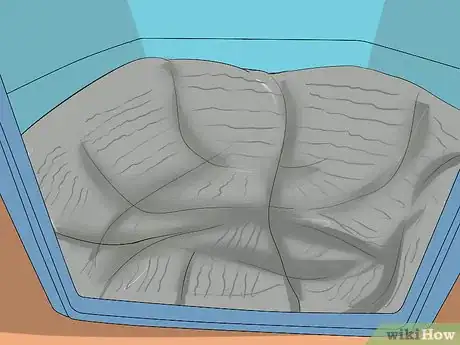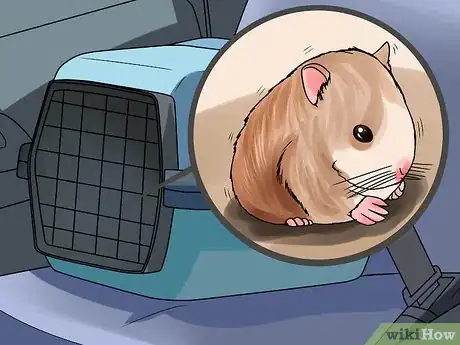This article was co-authored by Pippa Elliott, MRCVS. Dr. Elliott, BVMS, MRCVS is a veterinarian with over 30 years of experience in veterinary surgery and companion animal practice. She graduated from the University of Glasgow in 1987 with a degree in veterinary medicine and surgery. She has worked at the same animal clinic in her hometown for over 20 years.
wikiHow marks an article as reader-approved once it receives enough positive feedback. In this case, 96% of readers who voted found the article helpful, earning it our reader-approved status.
This article has been viewed 107,490 times.
There may be some times when you have to transport your guinea pig. This could be a quick trip to the vet or a friend's for a few days while you go away. However, cars can be dangerous places for a guinea pig (or any other small animal). To give your guinea pig a smooth and safe ride, you should prepare well for the trip and keep the guinea pig's safety and comfort in mind while you are traveling.
Steps
Preparing to Transport Your Guinea Pig
-
1Buy a carrier. It should be made of cloth or plastic and not of metal or thick mesh. This carrier doesn't need to be made specifically for guinea pigs. Any small animal carrier that is big enough should work. Choose a carrier that is big enough for your pet to turn around, lie down, stand up, and a little extra room to move around in it.
- While the carrier shouldn't be made of metal or thick mesh, it can have a wire mesh door.
-
2Line the carrier with newspaper. Use a thickness of 20 sheets or more. A newspaper will not make a mess like bedding. You can cover it with fleece to make it cozier.Advertisement
-
3Put a handful of timothy hay in the carrier. Hay is an essential food for guinea pigs. They like to sleep in the hay and munch on it for comfort, and they should never be without it.
- Guinea pigs should have an unlimited supply of timothy hay at all times. This includes when they are traveling.[3]
-
4Put fruits and vegetables in your pet carrier. Soak the fruits and vegetables in water and then place them in a food bowl. This is important moisture for the guinea pig, as your pet will not have water on its trip.
- Do not put a ceramic food dish in the carrier, as it might slide and harm your guinea pig.
-
5Put a water bottle in the carrier if you are taking a long trip. If you are going for a very long car trip, for instance, more than a couple hours, your guinea pig will need access to water. In cases such as this, you will need to attach a water bottle to your guinea pig's carrier and clean up any spilled water regularly.
- For instance, clean up any water covered bedding every time you stop the car for a break.
-
6Prepare the temperature of the car. Make sure that the car is at an appropriate temperature before you bring your a guinea pig in the car. In the winter, this may mean heating the car for a while. In the summer, this probably means cooling the car down before you put the guinea pig in it.
- Guinea pigs like to be at a temperature between 65 and 75 degrees. Try to get your car's temperature in this range before putting the guinea pig in it.[4]
Transporting Your Guinea Pig
-
1Place the guinea pig in the carrier. If your guinea pig is docile, you can simply pick it up and place it in the carrier. Usually, you put one hand under the guinea pig's belly and one under the guinea pig's hind legs.
- If the guinea pig is skittish, you may need to have a stronger grip on the guinea pig. Corner it in its cage and get ahold of it as you would with a more docile guinea pig, but hold on a little tighter. Make sure the carrier is very close by, so you can quickly move the guinea pig straight into the carrier.
- Once the guinea pig is inside of the carrier, close it properly. Make sure the carrier is secure and your guinea pig is as comfortable as possible.
- You can put two guinea pigs in the same carrier. If you are traveling with more than one guinea pig, it is perfectly fine to put them both together in one carrier. However, you must keep checking on them both to see if they are getting along.
-
2Put the guinea pig cage in a secure location in the car. Good locations include in a footwell (it may be warmer here than the rest of the car) or on a seat with the seat belt fastened. Bad locations include places where the carrier will slide around and jolt when you stop, near the heating and air-conditioning (because it could be too hot or too cold), in the trunk, or on someone's lap (in the event of a crash, the carrier could harm the person holding it).
- Also make sure that your guinea pig's cage will not be in the sun while you drive. This can quickly lead to the guinea pig getting overheated.
- You should also avoid putting your guinea pig's cage next to your stereo speakers if you are planning on playing your stereo. Guinea pigs are sensitive to sound, so they should not be exposed to loud sounds from your car stereo.[5]
-
3Drive your car responsibly. Begin to drive slowly and then pick up speed as if not to startle the guinea pig. Take turns slowly and try to make all driving adjustments, such as braking, gradually.
- The goal should be to give the guinea pig a calm ride in the car. Abrupt movements and aggressive driving will move your guinea pig around in its cage involuntarily. This will most likely agitate the pig.
-
4Check on the guinea pig regularly. If you are taking a long drive, for instance, if you are moving cross country, you need to check in on your pet regularly. Make sure it is doing ok and that its food and water are still secure.
- For example, take a five-minute break about halfway through your journey if you are traveling for over thirty minutes. Take this time to check their food and hay supply, as they need an unlimited supply of these.
- If you are on a long drive and your guinea pig's food or water spills all over its cage, clean it up. You don't want your pet sitting in a dirty cage for hours while you drive.
-
5Look for signs of distress. Guinea pigs may naturally hide and be fearful during a car ride, so this is not necessarily a sign of true distress. However, there are some signs that the guinea pig is in real distress and needs attention. These can include repeated loud squeals, pacing, cowering in fear, and staying crouched over.[6]
- If you have had your guinea pig for a while, you should know if it is acting normally. However, remember that a guinea pig being transported is likely to exhibit some unusual behavior.
- Talk to the guinea pig during the ride. It may be comforting to the pig to know that you're there with it.
- Never leave your guinea pig in the car alone! It can get overheated very quickly in a closed up car.[7]
Expert Q&A
Did you know you can get expert answers for this article?
Unlock expert answers by supporting wikiHow
-
QuestionWhat temperature should guinea pigs be in?
 Pippa Elliott, MRCVSDr. Elliott, BVMS, MRCVS is a veterinarian with over 30 years of experience in veterinary surgery and companion animal practice. She graduated from the University of Glasgow in 1987 with a degree in veterinary medicine and surgery. She has worked at the same animal clinic in her hometown for over 20 years.
Pippa Elliott, MRCVSDr. Elliott, BVMS, MRCVS is a veterinarian with over 30 years of experience in veterinary surgery and companion animal practice. She graduated from the University of Glasgow in 1987 with a degree in veterinary medicine and surgery. She has worked at the same animal clinic in her hometown for over 20 years.
Veterinarian The ideal temperature for guinea pigs is 16-24 degrees C (61-75 degrees F). Guinea pigs easily suffer from heat stress, and temperatures 25 degrees C (77 degrees F) and above can cause heatstroke. However, they can cope with cooler temperatures, around 10-15 degrees C (50-50 degrees F), without too many problems when they have deep bedding.
The ideal temperature for guinea pigs is 16-24 degrees C (61-75 degrees F). Guinea pigs easily suffer from heat stress, and temperatures 25 degrees C (77 degrees F) and above can cause heatstroke. However, they can cope with cooler temperatures, around 10-15 degrees C (50-50 degrees F), without too many problems when they have deep bedding. -
QuestionCan guinea pigs travel in cars?
 Pippa Elliott, MRCVSDr. Elliott, BVMS, MRCVS is a veterinarian with over 30 years of experience in veterinary surgery and companion animal practice. She graduated from the University of Glasgow in 1987 with a degree in veterinary medicine and surgery. She has worked at the same animal clinic in her hometown for over 20 years.
Pippa Elliott, MRCVSDr. Elliott, BVMS, MRCVS is a veterinarian with over 30 years of experience in veterinary surgery and companion animal practice. She graduated from the University of Glasgow in 1987 with a degree in veterinary medicine and surgery. She has worked at the same animal clinic in her hometown for over 20 years.
Veterinarian
-
QuestionDo guinea pigs really need a friend?
 Pippa Elliott, MRCVSDr. Elliott, BVMS, MRCVS is a veterinarian with over 30 years of experience in veterinary surgery and companion animal practice. She graduated from the University of Glasgow in 1987 with a degree in veterinary medicine and surgery. She has worked at the same animal clinic in her hometown for over 20 years.
Pippa Elliott, MRCVSDr. Elliott, BVMS, MRCVS is a veterinarian with over 30 years of experience in veterinary surgery and companion animal practice. She graduated from the University of Glasgow in 1987 with a degree in veterinary medicine and surgery. She has worked at the same animal clinic in her hometown for over 20 years.
Veterinarian
Warnings
- Never travel with a guinea pig if it is not in a traveling cage. Holding it on your lap is not acceptable.⧼thumbs_response⧽
- Not all guinea pigs will eat on the drive. Some will refuse to touch their food until the vehicle is stopped.⧼thumbs_response⧽
- Carriers should never be used for permanent housing.⧼thumbs_response⧽
Things You'll Need
- Carrier
- Newspaper
- Hay
- Fruits or vegetables
- Car
- Your guinea pigs
References
- ↑ http://www.smallanimalchannel.com/guinea-pigs/guinea-pig-housing/guinea-pig-travel-tips.aspx
- ↑ http://www.humanesociety.org/animals/guinea_pigs/tips/guinea_pig_housing.html?credit=web_id139895298
- ↑ http://www.humanesociety.org/animals/guinea_pigs/tips/guinea_pig_feeding.html?credit=web_id139895298
- ↑ http://www.humanesociety.org/animals/guinea_pigs/tips/guinea_pig_housing.html?credit=web_id139895298
- ↑ http://www.humanesociety.org/animals/guinea_pigs/tips/guinea_pig_housing.html?credit=web_id139895298
- ↑ https://www.rarc.wisc.edu/animal_health/pain_and_distress.html
- ↑ http://www.smallanimalchannel.com/guinea-pigs/guinea-pig-housing/guinea-pig-travel-tips.aspx
About This Article
To transport your guinea pig safely in the car, start by lining a cloth or plastic carrier with newspaper. Then, place a handful of hay in the carrier so it has something to eat. Next, put your guinea pig in the carrier and place it in a secure location, like the foot well or on a chair with the seatbelt fastened. Make sure the temperature in your car is around 65 to 75 degrees Fahrenheit, which is ideal for guinea pigs. Additionally, try to change your speed and turn slowly while driving so you don't startle your guinea pig. For tips on how to tell if your guinea pig is stressed during the trip, keep reading!









































































